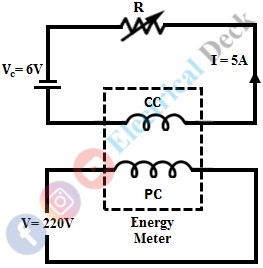In the energy meter testing, the actual registration of energy (by the meter) is verified against known standard values at various loads and power factors. The energy meter testing helps in providing suitable adjustments in the meter so as to reduce errors. The actual registration is verified under the following test conditions.
- At rated voltage, 5% of rated current and unity power factor.
- At rated voltage, 125% of rated current and unity power factor.
- At rated voltage, rated current, and 0.5 lagging power factor.
- At rated voltage, 50% of rated current and unity power factor.
- At rated voltage, 0.5% of rated current and unity power factor. This test is called starting test. Since, at this small load also, the disc should start rotating, Of course, accuracy is not the criteria in this test.
- At 110% of rated voltage and open-circuited current coil. This test is called as creep test. The disc should not creep (or rotate) under this test conditions.
In order to test high capacity energy meters for the above conditions, tremendous loss of power will occur. Hence, to reduce wastage of power, phantom loading is used for testing the energy meter.
Phantom Loading :
Phantom loading is a fictitious loading that resembles the actual full-load conditions. The main advantage of testing a meter under phantom loading conditions over direct loading one is that the power or energy consumption is comparatively too small.
As shown in the figure above, the pressure coil (or the shunt winding) is energized with its rated voltage and the current coil (or the series winding) is energized by a low voltage supply. The impedance of the current coil circuit is quite small. So for the rated amount of current also, the power consumption will be small. Although the impedance of the pressure coil is high, the current through it is very small.
Hence, the power consumed in the pressure coil will also be small. Therefore, the overall power or energy dissipation during the testing period will be small. For this reason, phantom loading is considered to be the most economical one for testing purposes.
Example on Phantom Loading :
Consider a 220V, 5A, dc energy meter is tested at the marked ratings. The resistance of the pressure coil circuit is 8800 ohm and that of a current coil is 0.1 ohm. Let us see the power consumed when testing the meter by direct loading and phantom loading.









